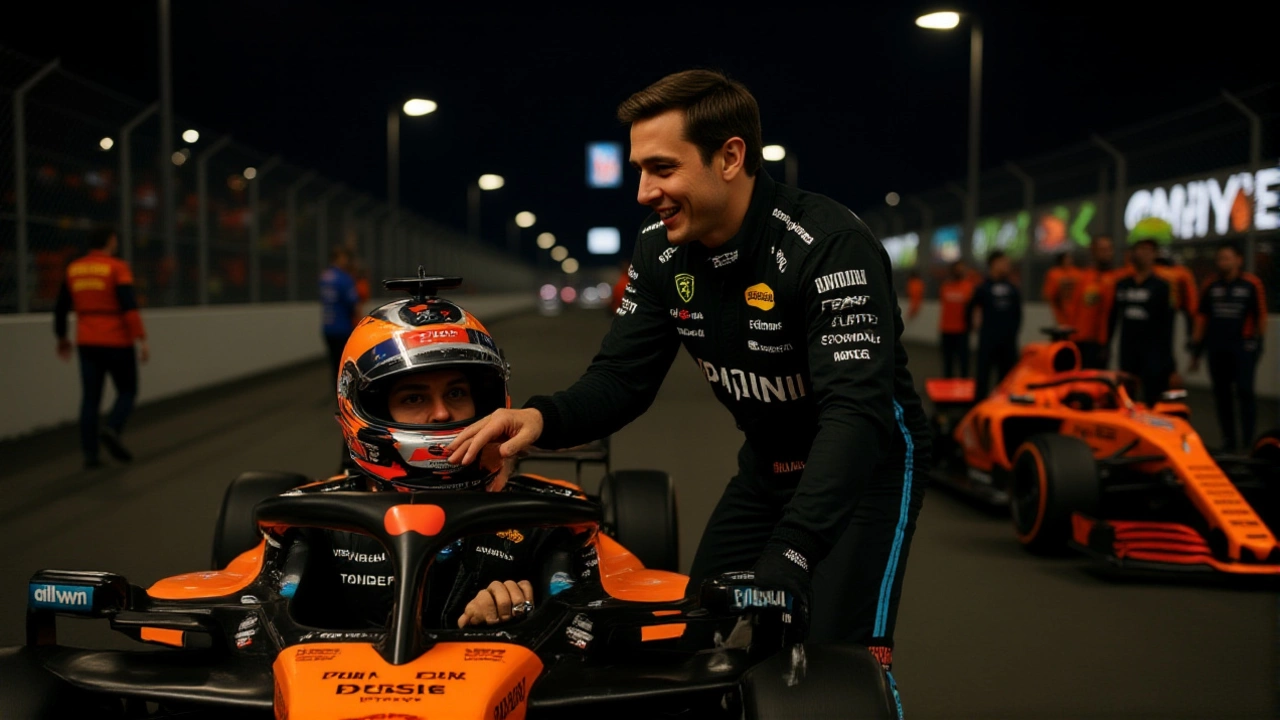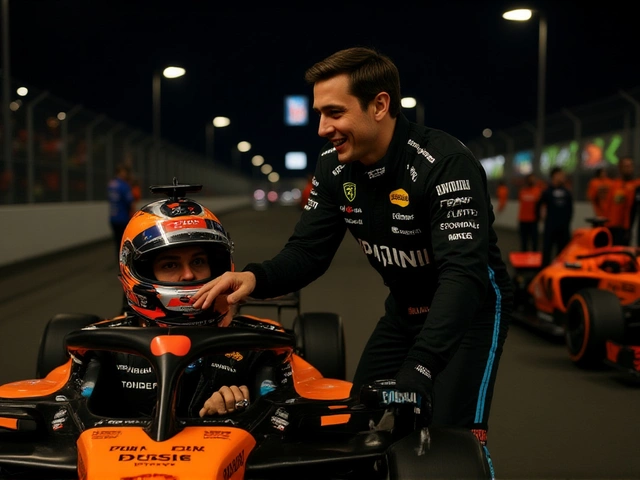Max Verstappen crossed the finish line first at the Formula 1 Heineken Las Vegas Grand Prix 2025Las Vegas Strip Circuit on Sunday, November 23, 2025 — but the real story wasn’t his victory. It was the bombshell that came after the checkered flag: McLaren Racing’s Lando Norris and Oscar Piastri were disqualified for illegal skid block wear, turning a 1-2 finish into a 1-0 disaster and sending shockwaves through the 2025 Drivers’ Championship. Verstappen, driving for Oracle Red Bull Racing, won in 1 hour, 21 minutes, and 8.429 seconds, but the real drama unfolded in the stewards’ room, where technical inspectors found both McLarens had worn their underbody skid blocks beyond FIA limits — a violation that cost them not just podium finishes, but championship momentum.
The Race That Wasn’t Supposed to Be This Dramatic
Before the race, the narrative was simple: Norris, who’d snatched pole with a blistering 1:52.821 in wet qualifying, was the man to beat. He’d outpaced Verstappen by 0.323 seconds on Saturday, November 22, in conditions that had turned the Las Vegas Strip into a slick, unpredictable track. Piastri qualified fifth, and the McLaren duo looked set to dominate. But on the opening lap, Norris lost control exiting Turn 1, allowing Verstappen to slip past. By Lap 5, the Dutchman was already 3.2 seconds ahead. The race settled into a predictable rhythm — until the stewards’ post-race announcement.Disqualification: A Technical Blow, Not a Racing One
Skid blocks — the titanium-plated plates beneath F1 cars — are strictly regulated to prevent teams from running cars too low to the ground for aerodynamic advantage. FIA rules mandate a minimum thickness of 8mm at the end of a race. Norris’s McLaren measured 6.1mm. Piastri’s was even worse: 5.9mm. Both were well below the legal threshold. The team had been pushing the limits all weekend, using aggressive ride height adjustments to maximize downforce on the bumpy Las Vegas Strip. But when the cars were scanned after the race, the damage was undeniable. "It’s a heartbreaking outcome," said McLaren Team Principal Andrea Stella in a post-race statement. "We didn’t break any rules intentionally. But we failed to manage the wear properly. That’s on us. We take full responsibility." The disqualifications elevated Mercedes-AMG Petronas Formula One Team’s George Russell to second place (+23.546s), while rookie Andrea Kimi Antonelli — who’d received a five-second penalty for a false start — climbed to third (+30.488s). Charles Leclerc of Scuderia Ferrari finished fourth, and Carlos Sainz of Williams Racing fifth, securing the team’s best constructor result since 2017.Championship Chaos: Norris Still Leads — But Now It’s a Tightrope
Before Las Vegas, Norris led the Drivers’ Championship with 318 points — 24 ahead of Piastri and 49 ahead of Verstappen. With 83 points still available across the final three races, he was the favorite. Now? He still leads, but his advantage is thinner than ever. Verstappen, now on 269 points, is just 49 behind. And with Piastri’s points erased, the McLaren internal battle is over — but the championship door is wide open. "It’s not over," Norris said in a quiet, candid interview. "I still have the points. But I also have the weight of knowing we threw away a chance to make this easier. Now I have to win in Qatar — and hope others stumble." Meanwhile, Lewis Hamilton, starting 20th after a disastrous Q1, fought his way to eighth — his best finish since joining Ferrari — thanks to a conservative hard-tyre strategy and flawless pit stops. "I didn’t think I’d be in the top 10," Hamilton admitted. "But this track rewards patience. And sometimes, you just have to outlast the chaos."
The Ripple Effect: Teams Warned, Rules Tightened
The FIA didn’t stop at disqualifications. On Monday, it issued a formal warning to three teams — including McLaren — for manipulating tire temperatures to artificially reduce skid block wear during the race. "We’ve seen this trick before," said FIA Technical Delegate Niels Wittich. "It’s not new. But this time, it crossed the line." Teams are now under strict orders to submit real-time skid block wear data during races. Any team caught adjusting ride height via tire heating will face immediate penalties. The message is clear: no more gray areas.What’s Next? Qatar’s High-Stakes Showdown
The next race, on November 29, 2025, at the Lusail International Circuit in Qatar, could crown the champion. Norris needs only to finish ahead of Verstappen by a narrow margin to lock it in — if he scores maximum points and Verstappen finishes sixth or lower. But with the pressure mounting, and the McLaren team reeling from the scandal, the pressure is on him to deliver — not just as a driver, but as a leader. Verstappen, meanwhile, is calm. "I don’t care how they got here," he said after the race. "I just care that I’m still in the fight. And I’m not done yet."
Background: The Skid Block Rule — Why It Matters
Skid blocks aren’t just technical components — they’re the FIA’s way of enforcing a level playing field. Introduced in 2001 to prevent teams from running ultra-low ride heights, they’ve been a silent guardian of fairness. In 2019, Ferrari was fined $100,000 for excessive wear after the Austrian Grand Prix. In 2021, Red Bull was docked points after a similar violation. But never before had two drivers from the same team been disqualified in the same race for this offense.Who Really Won? The Fans, Maybe
For all the controversy, the Las Vegas GP delivered something rare: unpredictability. The disqualifications turned a predictable race into a championship thriller. Fans saw Hamilton claw back from 20th. Antonelli, 18, burst onto the scene as a future star. And Verstappen, ever the cool operator, kept his focus while the world around him unraveled. It wasn’t the race anyone expected. But it might be the one that defines the 2025 season.Frequently Asked Questions
How did the skid block violation happen, and why is it such a big deal?
Skid blocks are mandatory underbody components that prevent teams from running cars too low for aerodynamic gain. FIA rules require a minimum thickness of 8mm after a race. McLaren’s cars measured 5.9mm and 6.1mm — well below legal limits. This isn’t just a paperwork issue; it’s a safety and fairness violation. Teams that exploit this gain significant downforce, giving them an unfair edge — which is why penalties are severe.
What does this mean for Lando Norris’s championship chances?
Norris still leads with 318 points, but his margin is now razor-thin. With Verstappen at 269, and only 83 points left, Norris must finish ahead of Verstappen by at least 5 positions in Qatar to guarantee the title. If Verstappen wins and Norris finishes fifth or lower, the gap narrows to just 14 points — meaning the final two races could be a nail-biter. The disqualification didn’t erase his lead — but it made it far more fragile.
Why did George Russell move up to second despite finishing fourth on track?
Russell crossed the line in fourth, but after Norris and Piastri were disqualified, all drivers behind them moved up one position. That meant Russell, who finished fourth, became second. Andrea Kimi Antonelli, who originally finished fifth (and had received a five-second penalty), moved to third. The FIA recalculates final standings based on official classification — not just finish order — after disqualifications.
Could McLaren appeal the disqualification?
Technically, yes — but it’s unlikely to succeed. The skid block measurements were confirmed by three independent FIA inspectors using calibrated laser tools. The team admitted to the wear in their own telemetry data. Appeals in such cases are rarely overturned unless procedural errors are proven — and none were found. McLaren has not announced an appeal, suggesting they accept the outcome.
How did Lewis Hamilton finish eighth after starting 20th?
Hamilton ran a unique strategy: he started on the hard compound tire — the same as Kick Sauber’s Nico Hulkenberg — and stayed out until Lap 26, avoiding early pit stops that bunched up traffic. With many drivers struggling with tire degradation on the abrasive Las Vegas surface, Hamilton’s long first stint allowed him to pass slower cars cleanly. He gained 12 positions in the first 15 laps alone, turning a disaster into a career-defining recovery drive.
What’s the significance of Williams Racing finishing fifth in the constructors’ standings?
Williams hasn’t finished higher than fifth in the constructors’ championship since 2017. Carlos Sainz’s fifth-place finish in Las Vegas, combined with the collapse of McLaren’s points, gives Williams a 28-point cushion over Alpine and a 41-point lead over Aston Martin with only two races left. This is the most likely path to their best result in eight years — a major milestone for a team still rebuilding after years of struggle.

